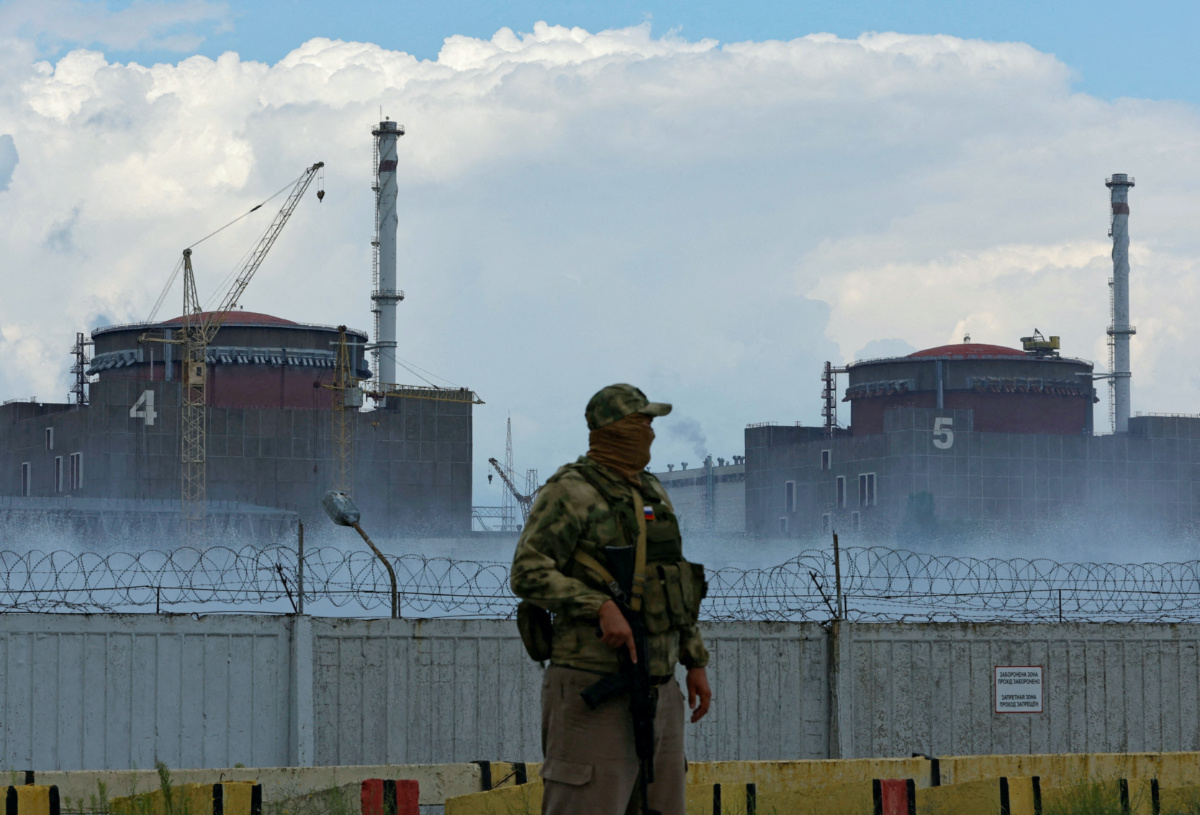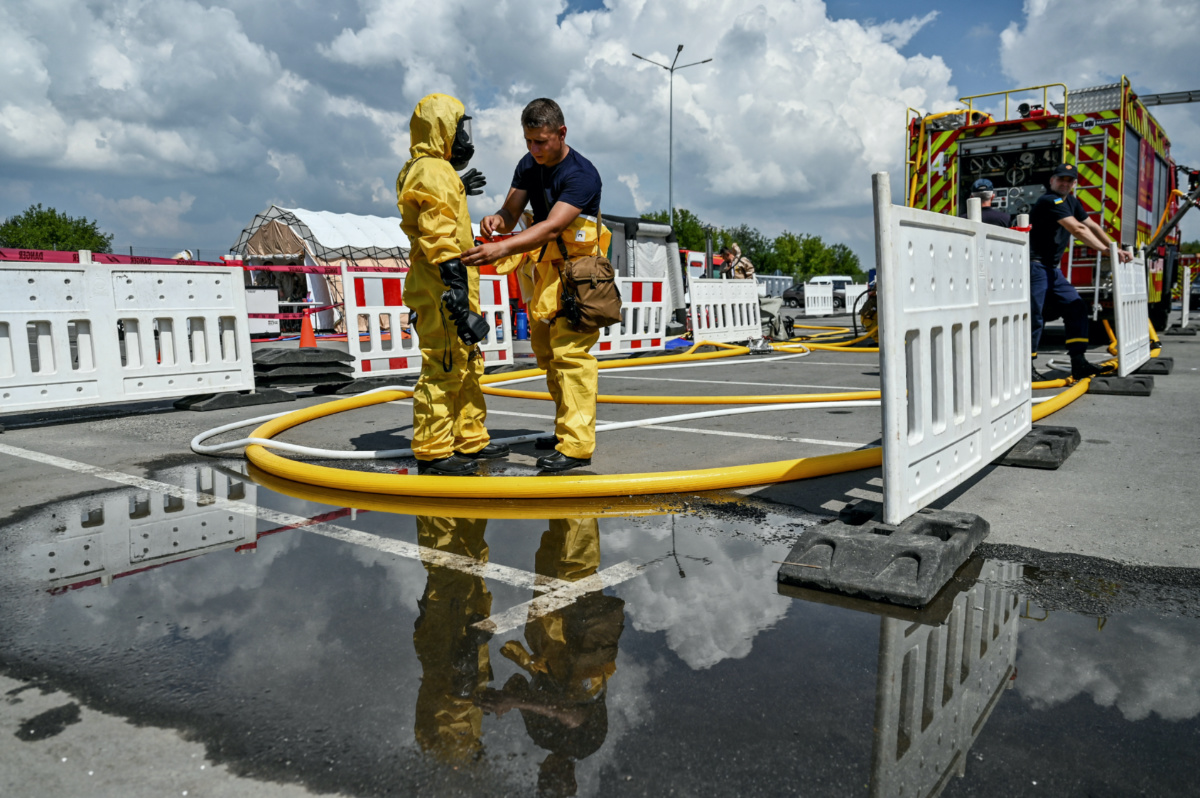Kyiv, Ukraine
Reuters
Ukrainian technicians at the Russian-held nuclear power plant hit by shelling work under the barrels of Russian guns and face huge pressure, but they are staying on to make sure there is no Chernobyl-style disaster, one of them said.
The technician, who asked that his identity not be disclosed for fear of Russian reprisals, offered a rare glimpse into the fraught working conditions at the Zaporizhzhia plant, which Moscow and Kyiv accuse each other of shelling.

A serviceman with a Russian flag on his uniform stands guard near the Zaporizhzhia Nuclear Power Plant in the course of Ukraine-Russia conflict outside the Russian-controlled city of Enerhodar in the Zaporizhzhia region, Ukraine, on 4th August. PICTURE: Reuters/Alexander Ermochenko
Europe’s biggest nuclear plant was captured by Russia in March and the bouts of shelling have been widely condemned, prompting calls for an urgent mission of the International Atomic Energy Agency to the facility in southern Ukraine.

Members of the State Emergency Service prepare for nuclear disaster response drills amid shelling of Zaporizhzhia Nuclear Power Plant, as Russia’s attack on Ukraine continues, in Zaporizhzhia, Ukraine, on 17th August. PICTURE: Reuters/Dmytro Smolienko
UKRAINE CARRIES OUT EMERGENCY DRILLS NEAR NUCLEAR PLANT ON FRONTLINE
Ukrainian authorities performed disaster response drills on Wednesday following repeated shelling at the Russian-occupied Zaporizhzhia nuclear power plant, the largest of its kind in Europe.
Both sides accuse the other of attacks in the vicinity of the facility in recent days and engaging in what they call “nuclear terrorism”.
UN Secretary-General Antonio Guterres, who wants a demilitarised zone to be established around the plant to avoid a potential catastrophe, will meet Ukrainian President Volodymyr Zelenskiy and Turkish President Tayyip Erdogan on Thursday for talks.
As part of the emergency drills, Ukrainian first responders donned full protective gear and then dealt with a man pretending to be a victim. After the team carried out a radiation scan they laid the patient on a stretcher, covered him in shiny silver film and then put him into an ambulance.
The first responders were themselves then checked for radiation before being hosed down and disposing of their gear. The drills will be repeated in the coming days, authorities said.
Ukrainian Energy Minister Herman Halushchenko said his government was very concerned about the safety of the plant in Enerhodar in the south-east of the country.
“That’s why we’re here, that’s why we’ve created this group,” Halushchenko told reporters.
Ukraine and Russia have said they want International Atomic Energy Agency inspectors to visit the plant. The agency’s chief, Rafael Grossi, has said he is ready to lead a mission.
“They need to give some technical estimation on what is happening because we just don’t have concrete information on what is happening inside,” Halushchenko said.
The plant is still run by Ukrainian technicians even though Russian forces captured it in March during the early stages of its invasion of Ukraine.
Moscow calls its invasion an operation to demilitarise its neighbour and protect Russian-speaking communities. Ukraine and its allies accuse Russia of waging an imperial-style war of conquest.
– IVAN LYUBYSH-KIRDEY, Zaporizhzhia, Ukraine/Reuters
The technician told Reuters that many workers had sent their families away from the town of Enerhodar where the plant is located, but had stayed on themselves to ensure the station’s safe operation.
“The employees understand they need to get their families out, but they themselves come back. They have to work because of the possibility of a major catastrophe like Chornobyl in 1986 and that would be much worse,” the technician said.
Heavily-armed Russian troops are everywhere at the site, which is in itself highly unnerving, and armoured personnel carriers have their barrels pointed at the entrance as workers enter, he added.
The Russian forces sometimes don’t immediately allow workers home after their shifts, he said.
“They find a reason not to let [employees] out – shelling, or they come up with something else,” he said.
“They’re constantly walking around the premises with guns. It’s very hard when you go into the plant and see these people and have to be there. It’s very mentally and psychologically taxing.”
The Russian Defence Ministry did not immediately reply to a request for a comment.
Energoatom, the top Ukrainian state body that normally oversees the plant, said it believed the facility’s workers were being pressured and were also in danger.
It referred Reuters to comments made by its chief Petro Kotin on 2nd August in which he said the staff were working under “intense psychological and physical pressure”, and complained about the Russian military presence at the site.
The nuclear power plant had 11,000 personnel before Russia invaded on 24th February. Ukrainian authorities are not disclosing the current number of workers, citing security reasons.
One of the constant fears is the electricity lines to the plant could be severed because the pumps that cool the reactor core and spent fuel pools need electricity to function, the technician said.
There is a backup electricity station that runs on diesel, but the technician said he did not know how much diesel fuel was left at the site.
The town of Enerhodar had a pre-war population of more than 50,000. The town’s mayor, Dmytro Orlov, told Reuters that around 25,000 people remain.
Around 1,000 of the plant’s employees had left the town by July, Energoatom’s spokesperson Leonid Oliynyk told Reuters, adding that he had no data for their family members.
Even though only two of the six reactors are functioning currently, there is still a huge amount of important safety work for staff to do, the technician said. Four of the plant’s six reactors are not working at normal capacity currently, but they still require proper maintenance, he said.
“The staff came back to maintain control because the security of Ukraine is at stake and that of the whole European continent and the world,” the technician said.
We rely on our readers to fund Sight's work - become a financial supporter today!
For more information, head to our Subscriber's page.
As several bouts of shelling have hit the complex of the nuclear power plant, Ukraine and Russia have said they want IAEA inspectors to visit the facility and the agency’s chief Rafael Grossi has said he is ready to lead a mission.
The United Nations has said it can facilitate such a trip, but that Ukraine and Russia have to agree on it.
The technician voiced scepticism that a trip to the facility by an IAEA mission would help much.
“Only the full de-occupation of the town, the nuclear station, the thermal power plant, Zaporizhzhia and Kherson regions and others, only then will people actually be safe,” he said.
There was no immediate response from the IAEA to a Reuters request for comment.






